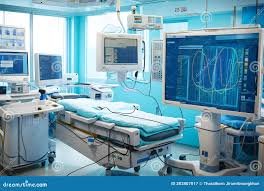Introduction
“Innovation in Healing: Exploring Cutting-Edge Technologies in Hospital Care” delves into the revolutionary technologies shaping the landscape of modern healthcare. From robotic surgery systems to state-of-the-art diagnostic tools, this article offers a comprehensive overview of how hospitals harness cutting-edge innovations to deliver superior patient care.
Robotic Surgery: Precision and Efficiency
Robotic surgery represents a paradigm shift in surgical precision and efficiency. By leveraging robotic arms controlled by skilled surgeons, hospitals can perform minimally invasive procedures with unparalleled accuracy. Discover how this transformative technology is revolutionizing surgical outcomes and recovery times.
Telemedicine has emerged as a vital tool for expanding access to healthcare services, particularly in remote or underserved areas. Through virtual consultations and remote monitoring, hospitals can connect patients with specialized care and resources, regardless of geographic barriers. Learn how telemedicine is bridging gaps in access to care and empowering patients to take control of their health.
Artificial Intelligence: Enhancing Diagnostic Accuracy
Artificial intelligence (AI) holds immense potential for enhancing diagnostic accuracy and efficiency in healthcare settings. Advanced AI algorithms can analyze vast amounts of medical data to identify patterns and trends that may escape human detection. Explore how hospitals are leveraging AI-powered diagnostic tools to expedite diagnosis and improve treatment outcomes for patients.
3D Printing: Custom Solutions for Patient Care
3D printing technology is revolutionizing the way hospitals approach patient care by enabling the creation of custom solutions tailored to individual needs. From prosthetics to surgical implants, 3D printing allows for the precise fabrication of medical devices that enhance patient comfort and functionality. Discover how hospitals are harnessing the power of 3D printing to deliver personalized care solutions.
Virtual Reality: Immersive Therapeutic Interventions
Virtual reality (VR) technology is transforming the landscape of therapeutic interventions by providing immersive experiences that promote healing and rehabilitation. Hospitals are utilizing VR simulations for pain management, cognitive therapy, and even surgical training. Learn how virtual reality is revolutionizing patient care and improving outcomes across a range of medical specialties.
Internet of Things (IoT): Connected Healthcare Ecosystems
The Internet of Things (IoT) is ushering in a new era of connected healthcare ecosystems, where medical devices and systems communicate seamlessly to optimize patient care. From wearable fitness trackers to smart hospital beds, IoT-enabled technologies provide real-time data insights that inform clinical decision-making and improve patient outcomes. Explore how hospitals are embracing IoT to create smarter, more efficient healthcare environments.
Biomedical Engineering: Pushing the Boundaries of Possibility
Behind every cutting-edge medical technology lies the expertise of biomedical engineers who design, develop, and innovate solutions that push the boundaries of possibility. From bioengineered tissues to implantable medical devices, biomedical engineering plays a crucial role in advancing healthcare innovation. Discover the remarkable contributions of biomedical engineers to the field of modern medicine.
Augmented Reality: Enhancing Surgical Visualization
Augmented reality (AR) technology offers surgeons enhanced visualization capabilities during complex procedures, allowing for more precise and informed decision-making. By overlaying digital information onto the surgical field in real-time, AR systems provide surgeons with invaluable insights that enhance surgical accuracy and patient safety. Learn how augmented reality is reshaping the future of surgical practice.
Data Analytics: Driving Evidence-Based Care
Data analytics is revolutionizing healthcare delivery by providing insights that enable evidence-based decision-making and personalized patient care. By analyzing vast datasets, hospitals can identify trends, predict outcomes, and tailor treatment plans to individual needs. Explore how data analytics is empowering hospitals to deliver more effective, efficient, and patient-centric care.
Conclusion
In conclusion, “Innovation in Healing: Exploring Cutting-Edge Technologies in Hospital Care” offers a glimpse into the transformative power of technology in modern healthcare. From robotic surgery to artificial intelligence, hospitals are embracing innovative solutions that enhance patient outcomes, improve access to care, and redefine the boundaries of healing possibilities.
